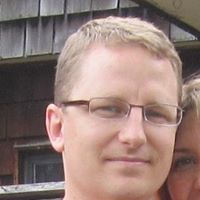Jason P Hoppa
from Springdale, OH
Jason Hoppa Phones & Addresses
- 11933 Eider Dr, Cincinnati, OH 45246 • 5136715804
- Springdale, OH
Resumes

Senior Staff Engineer
view sourceLocation:
Olde, West Chester, OH
Industry:
Airlines/Aviation
Work:
Ge Aviation
Senior Staff Engineer
Ge Aviation Mar 2016 - Sep 2016
Manager - Test Mechanical Engineering
Ge Aviation Feb 2010 - Mar 2016
Manager - Combustor Ht and Cooling Design
Ge Aviation Jun 1996 - Feb 2010
Combustor Mechanical Design
Senior Staff Engineer
Ge Aviation Mar 2016 - Sep 2016
Manager - Test Mechanical Engineering
Ge Aviation Feb 2010 - Mar 2016
Manager - Combustor Ht and Cooling Design
Ge Aviation Jun 1996 - Feb 2010
Combustor Mechanical Design
Education:
University of Cincinnati 1999 - 2003
Master of Science, Masters, Mechanical Engineering University of Dayton 1991 - 1996
Bachelors, Bachelor of Science, Mechanical Engineering
Master of Science, Masters, Mechanical Engineering University of Dayton 1991 - 1996
Bachelors, Bachelor of Science, Mechanical Engineering
Skills:
Finite Element Analysis
Ansys
Aerospace
Gas Turbines
Unigraphics
Aerodynamics
Cfd
Engineering
Mechanical Engineering
Composites
Stress Analysis
Fluid Mechanics
Aircraft
Engineering Management
Propulsion
Fluid Dynamics
Siemens Nx
Nx Unigraphics
Six Sigma
Systems Engineering
Computational Fluid Dynamics
Ansys
Aerospace
Gas Turbines
Unigraphics
Aerodynamics
Cfd
Engineering
Mechanical Engineering
Composites
Stress Analysis
Fluid Mechanics
Aircraft
Engineering Management
Propulsion
Fluid Dynamics
Siemens Nx
Nx Unigraphics
Six Sigma
Systems Engineering
Computational Fluid Dynamics
Languages:
English

Jason Hoppa
view sourceUs Patents
-
Methods And Apparatuses For Assembling A Gas Turbine Engine
view source -
US Patent:7637110, Dec 29, 2009
-
Filed:Nov 30, 2005
-
Appl. No.:11/290115
-
Inventors:Robert P. Czachor - Cincinnati OH, US
James Anthony Groeschen - Burlington KY, US
Jason Paul Hoppa - West Chester OH, US -
Assignee:General Electric Company - Schenectady NY
-
International Classification:F02C 7/20
-
US Classification:60796, 415136, 60800
-
Abstract:A method for assembling a gas turbine engine includes coupling a first structure within the gas turbine engine, wherein the first structure includes a plurality of sockets extending from a radially outer surface of the first structure, and coupling a second structure to the first structure by inserting a radial pin through the second structure and into each respective socket such that the first structure is aligned axially, circumferentially, and with respect to an engine centerline axis extending through the gas turbine engine, where the position of the pins relative to the second structure is adjustable.
-
Method Of Forming A Swirler With As-Cast Holes
view source -
US Patent:62057634, Mar 27, 2001
-
Filed:May 24, 1999
-
Appl. No.:9/317243
-
Inventors:Gilbert Farmer - Cincinnati OH
James A. Groeschen - Burlington KY
Jason P. Hoppa - Springdale OH
Stanford P. Seto - Loveland OH -
Assignee:General Electric Company - Cincinnati OH
-
International Classification:F02C13/10
-
US Classification:60 3902
-
Abstract:A method for determining the appropriate hole parameters to achieve the desired airflow in a swirler with as-cast air jet holes includes the steps of determining the desired airflow through the holes and selecting a hole angle for the holes. Next, the ratio of the hole exit area to the hole inlet area is calculated based on the desired airflow and the selected hole angle using a regression equation. Then a value is determined for either of the hole exit area or the hole inlet area, and the other area is calculated from the known ratio. Once the hole angle, hole exit area and hole inlet area have been determined, then a swirler can be cast with as-cast holes using these hole parameters.
Classmates

Jason Hoppa
view sourceSchools:
Calvary Baptist High School Menomonee Falls WI 1998-2002

Calvary Baptist High Scho...
view sourceGraduates:
Jason Hoppa (1998-2002),
Brenda Waltz (1987-1991),
Lani Waltz (1987-1989),
Christopher Kimberly (1986-1988)
Brenda Waltz (1987-1991),
Lani Waltz (1987-1989),
Christopher Kimberly (1986-1988)
Youtube
Myspace

Jason Hoppa
view source
Jason Hoppa
view source
Jason Hoppa
view sourceGet Report for Jason P Hoppa from Springdale, OH


![NLE Choppa - Bryson [Official Music Video] NLE Choppa - Bryson [Official Music Video]](https://i.ytimg.com/vi/1QfJya5dzl4/hq720.jpg?sqp=-oaymwEcCNAFEJQDSFXyq4qpAw4IARUAAIhCGAFwAcABBg==&rs=AOn4CLCo4a9d5ZuXKsxxhYYIpbA_7PqXFA)



